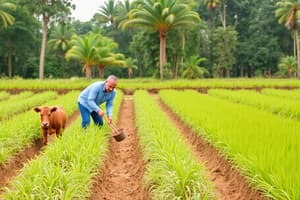Podcast
Questions and Answers
Which of the following crops is classified as a major food crop?
Which of the following crops is classified as a major food crop?
- Rubber
- Jute
- Cotton
- Rice (correct)
What type of climate is best suited for rice cultivation?
What type of climate is best suited for rice cultivation?
- Moderate temperature and low humidity
- High temperature and humidity (correct)
- Cold and dry
- Cool and temperate
Which crop requires well-drained loamy soil for optimal growth?
Which crop requires well-drained loamy soil for optimal growth?
- Cotton
- Wheat (correct)
- Maize
- Jute
Which of the following is considered a fibre crop?
Which of the following is considered a fibre crop?
What is the leading producer of rubber?
What is the leading producer of rubber?
Which crop can be grown on less fertile sandy soils?
Which crop can be grown on less fertile sandy soils?
Which of these is known as the 'Golden Fibre'?
Which of these is known as the 'Golden Fibre'?
Where is cotton primarily grown?
Where is cotton primarily grown?
What is the primary goal of subsistence farming?
What is the primary goal of subsistence farming?
Which type of subsistence farming is characterized by the use of simple tools and high labor intensity?
Which type of subsistence farming is characterized by the use of simple tools and high labor intensity?
What farming practice involves clearing land by burning vegetation?
What farming practice involves clearing land by burning vegetation?
In which regions is nomadic herding primarily practiced?
In which regions is nomadic herding primarily practiced?
Which of the following best describes commercial farming?
Which of the following best describes commercial farming?
Which type of farming primarily produces grains like wheat and maize for sale?
Which type of farming primarily produces grains like wheat and maize for sale?
What is a characteristic of mixed farming?
What is a characteristic of mixed farming?
Where is intensive subsistence agriculture primarily found?
Where is intensive subsistence agriculture primarily found?
Which country is the leading producer of jute?
Which country is the leading producer of jute?
What climate conditions are essential for coffee cultivation?
What climate conditions are essential for coffee cultivation?
Which of the following crops require a well-drained loamy soil?
Which of the following crops require a well-drained loamy soil?
What is the ultimate aim of agricultural development?
What is the ultimate aim of agricultural development?
In which countries is intensive agriculture typically practiced?
In which countries is intensive agriculture typically practiced?
What type of crops does Munna Lal grow on his farm in India?
What type of crops does Munna Lal grow on his farm in India?
What is a significant challenge faced by farmers like Munna Lal?
What is a significant challenge faced by farmers like Munna Lal?
What farming size is typical for a farm in the USA described?
What farming size is typical for a farm in the USA described?
What is the meaning of the word agriculture?
What is the meaning of the word agriculture?
Which category of economic activity includes the processing of flour into bread?
Which category of economic activity includes the processing of flour into bread?
What type of land is referred to as 'arable land'?
What type of land is referred to as 'arable land'?
Which of the following is NOT considered a tertiary activity?
Which of the following is NOT considered a tertiary activity?
What factor is essential for successful agricultural activity according to the information provided?
What factor is essential for successful agricultural activity according to the information provided?
Which term describes the commercial rearing of silk worms?
Which term describes the commercial rearing of silk worms?
What percentage of the world’s population is engaged in agricultural activity?
What percentage of the world’s population is engaged in agricultural activity?
Which of the following activities involves breeding fish in specially constructed tanks?
Which of the following activities involves breeding fish in specially constructed tanks?
Flashcards
Agriculture definition
Agriculture definition
Cultivating soil, growing crops, and raising livestock.
Primary activity
Primary activity
Extracting and producing natural resources, like farming, fishing, and gathering.
Secondary activity
Secondary activity
Processing resources (e.g., manufacturing steel, baking bread).
Tertiary activity
Tertiary activity
Signup and view all the flashcards
Arable land
Arable land
Signup and view all the flashcards
Agricultural inputs
Agricultural inputs
Signup and view all the flashcards
World agricultural distribution
World agricultural distribution
Signup and view all the flashcards
Agriculture's importance
Agriculture's importance
Signup and view all the flashcards
Subsistence Farming
Subsistence Farming
Signup and view all the flashcards
Intensive Subsistence Agriculture
Intensive Subsistence Agriculture
Signup and view all the flashcards
Primitive Subsistence Agriculture
Primitive Subsistence Agriculture
Signup and view all the flashcards
Shifting Cultivation
Shifting Cultivation
Signup and view all the flashcards
Nomadic Herding
Nomadic Herding
Signup and view all the flashcards
Commercial Farming
Commercial Farming
Signup and view all the flashcards
Commercial Grain Farming
Commercial Grain Farming
Signup and view all the flashcards
Mixed Farming
Mixed Farming
Signup and view all the flashcards
Plantation Farming
Plantation Farming
Signup and view all the flashcards
Major Food Crops
Major Food Crops
Signup and view all the flashcards
Rice: Growing Conditions
Rice: Growing Conditions
Signup and view all the flashcards
Wheat: Growing Conditions
Wheat: Growing Conditions
Signup and view all the flashcards
Maize: Growing Conditions
Maize: Growing Conditions
Signup and view all the flashcards
Cotton: Growing Conditions
Cotton: Growing Conditions
Signup and view all the flashcards
Jute: Growing Conditions
Jute: Growing Conditions
Signup and view all the flashcards
Fibre Crops
Fibre Crops
Signup and view all the flashcards
Jute: Where grown?
Jute: Where grown?
Signup and view all the flashcards
Coffee: Suitable climate?
Coffee: Suitable climate?
Signup and view all the flashcards
Tea: What makes it special?
Tea: What makes it special?
Signup and view all the flashcards
Agricultural development: What's the goal?
Agricultural development: What's the goal?
Signup and view all the flashcards
Intensive agriculture: How is it done?
Intensive agriculture: How is it done?
Signup and view all the flashcards
Commercial agriculture: What's the focus?
Commercial agriculture: What's the focus?
Signup and view all the flashcards
Munna Lal's challenges: What are they?
Munna Lal's challenges: What are they?
Signup and view all the flashcards
USA farms: What's the difference?
USA farms: What's the difference?
Signup and view all the flashcards
Study Notes
Agriculture
- Agriculture's Definition: The science and art of cultivating the soil, raising crops, and rearing livestock. Also called farming.
- Sericulture: Commercial rearing of silkworms, supplementing a farmer's income.
- Pisciculture: Fish breeding in constructed tanks or ponds.
- Viticulture: Grape cultivation.
- Horticulture: Growing vegetables, flowers, and fruits for commercial use.
Economic Activities in Agriculture
- Primary Activities: Involve resource extraction and production, including agriculture, fishing, and gathering.
- Secondary Activities: Processes natural resources, like manufacturing steel, making bread, and weaving cloth.
- Tertiary Activities: Provide support to primary and secondary sectors through services like transport, trade, banking, insurance, and advertising.
Types of Farming
- Subsistence Farming: Practiced to meet the needs of the farmer's family. Low technology use, typically small output. Can be further classified as:
- Intensive Subsistence: Small plots of land, intense labor, more than one crop annually. Common in areas with high population density, fertile soils, and lots of sunshine. Rice is a main crop.
- Primitive Subsistence: Using simple tools, labor-intensive, small scale output, often shifting cultivation or nomadic herding.
- Commercial Farming: Focuses on growing crops and raising animals for sale in the market. Large area and amount of capital are utilized. Often involves mechanized methods. Can be classified as:
- Commercial Grain Farming: Crops like wheat and maize are grown primarily for sale.
- Mixed Farming: Combining crops with livestock rearing on the same land.
- Plantation Agriculture: Large-scale, single crop production using substantial capital, like tea, coffee, sugarcane, rubber, or cashew.
World Agricultural Distribution
- Arable Land: Land suitable for growing crops. Distribution is concentrated in regions with suitable factors for crop growth.
- Food Crop Importance: 50% of the world's population is engaged in agricultural activity, with two-thirds of India's population significantly reliant on agriculture.
Agricultural Inputs and Outputs
- Inputs: Resources used in agriculture like machinery, seeds, chemicals, labor, sunshine, rainfall, temperature, soil, and slope, among others.
- Processes: Actions such as ploughing, sowing, irrigation, weeding, and harvesting employed to cultivate the crops.
- Outputs: Results of agricultural endeavors, including crops, wool, dairy, and poultry products.
Important Agricultural Crops
- Rice: Major food crop in tropical and subtropical areas (e.g., China, India, and parts of Southeast Asia). Grows best in warm, humid conditions with ample rainfall and on alluvial soils, which retain water.
- Wheat: Thrives in temperate zones with moderate temperatures and rainfall, well-drained soils, (e.g., USA, Canada, Argentina, Russia, and India). Grown mainly in winter.
- Millets: Also known as coarse grains, suitable for arid and semi-arid areas with low rainfall and sandy soils.
- Cotton: Needs warm weather, plenty of sunlight, and well-drained soils (e.g., China, USA, India, Pakistan, and Brazil).
- Coffee: Thrives in warm, humid regions with plenty of rainfall on slopes or well-drained soils (e.g., Brazil, Columbia, and India).
- Tea: Prefers cool climate with ample rainfall (e.g., India and Sri Lanka).
- Maize: Requires moderate rainfall, sunshine, and well-drained fertile soils (e.g., North America, Brazil, China, Russia, Canada, India and Mexico).
- Jute: Prefers high temperature, humidity, and heavy rainfall on alluvial soils (e.g., India and Bangladesh).
Additional Notes
- Farming practices in different parts of the world vary due to geographical differences.
- Agricultural development is about boosting food production.
- Agriculture in developed countries is characterized by larger farms usually utilized for commercial product.
- Agriculture in developing countries is typically more labor intensive and done on smaller scale farms to feed local populations.
- Mechanization in agriculture has improved efficiency and productivity in some countries but has negative implications in other areas.
Studying That Suits You
Use AI to generate personalized quizzes and flashcards to suit your learning preferences.




